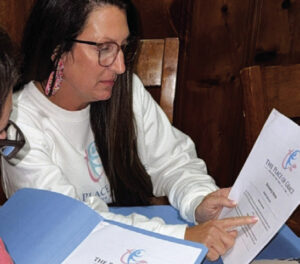Dangers of grazing broodmares on fescue
By By Justin Rodgers / county agent
Sept. 8, 2002
Mississippi State University researchers are looking for the best of both worlds as they evaluate the benefits and risks of two types of fescue when consumed by broodmares.
Tall fescue is an important forage grass for horses and is grown extensively throughout the southern and northeastern United States.
In the late 1980s, horse owners noticed increased foaling problems in mares pastured on fescue infected with an endophyte (fungus).
The endophyte is beneficial to the grass but produces ergot alkaloids that are toxic to livestock and horses. Horses are most susceptible to toxic fescue during pregnancy. "Some of the pregnancy complications include placental thickening, prolonged gestations, complicated deliveries, the absence or reduction of milk production, and high foal mortality," said Peter Ryan, assistant professor at MSU and animal and dairy scientist for the Mississippi Agricultural and Forestry Experiment Station.
The effects on late-term pregnancies were the focus for researchers in the first two years. During 2000 and 2001, 11 mares were grazed on toxic, endophyte-infected fescue, 11 were on nontoxic, endophyte-infected fescue and 12 were on endophyte-free fescue. Researchers collected blood and urine samples to perform hormone and ergot alkaloid analyses.
Newborns and the placenta were weighed at birth, and animal scientists watched for any abnormalities. Of the 11 mares on the nontoxic endophyte grass, only two had complications that were unrelated to fescue toxicity. Among the 12 mares on the endophyte-free pasture, only one required assistance during foaling, Ryan said.
Data from both years confirmed an increased risk to the foal when mares grazed on toxic fescue and minimal risk from the nontoxic, endophyte-infected fescue or the endophyte-free fescue.
In 2002, the third year of the study, researchers placed eight mares on each type of pasture before they were pregnant and kept them on those grasses to examine complications. Mares were monitored for early embryonic losses during the first 150 days of gestation. Ryan said early-term exposure has never been studied thoroughly. The researchers wanted to determine if pregnancy complications depended on when mares were placed on the grasses. By mid- to late spring of the first year, mares on the toxic fescue were performing poorly; of the five mares that tested pregnant, two had lost their embryos. In the nontoxic fescue pasture, six mares were determined to be pregnant and progressing normally, Ryan, said.
Other universities have conducted studies on the effect of fescue on horses and cattle, but MSU is the first to study the effect of nontoxic, endophyte-infected fescue on horses. Pennington Seed markets the grass under the name Max-Q. Pennington Seed and MAFES are co-sponsoring the study. David Lang, associate professor of plant and soil sciences, is part of the team analyzing the grass. Jessup is one of two varieties of nontoxic, endophyte-infected fescues developed by Mississippi native and MSU alumnus Joe Bouton. Researchers are monitoring the toxicity in fescue throughout its use from pasture to hay.













